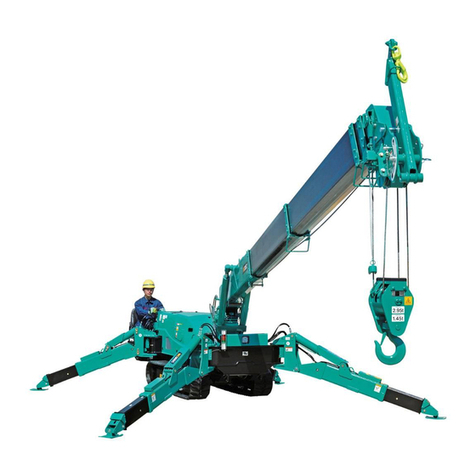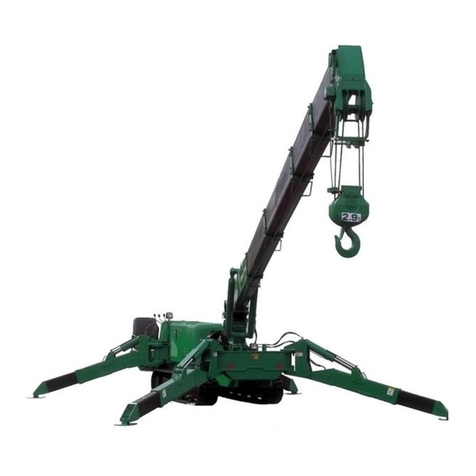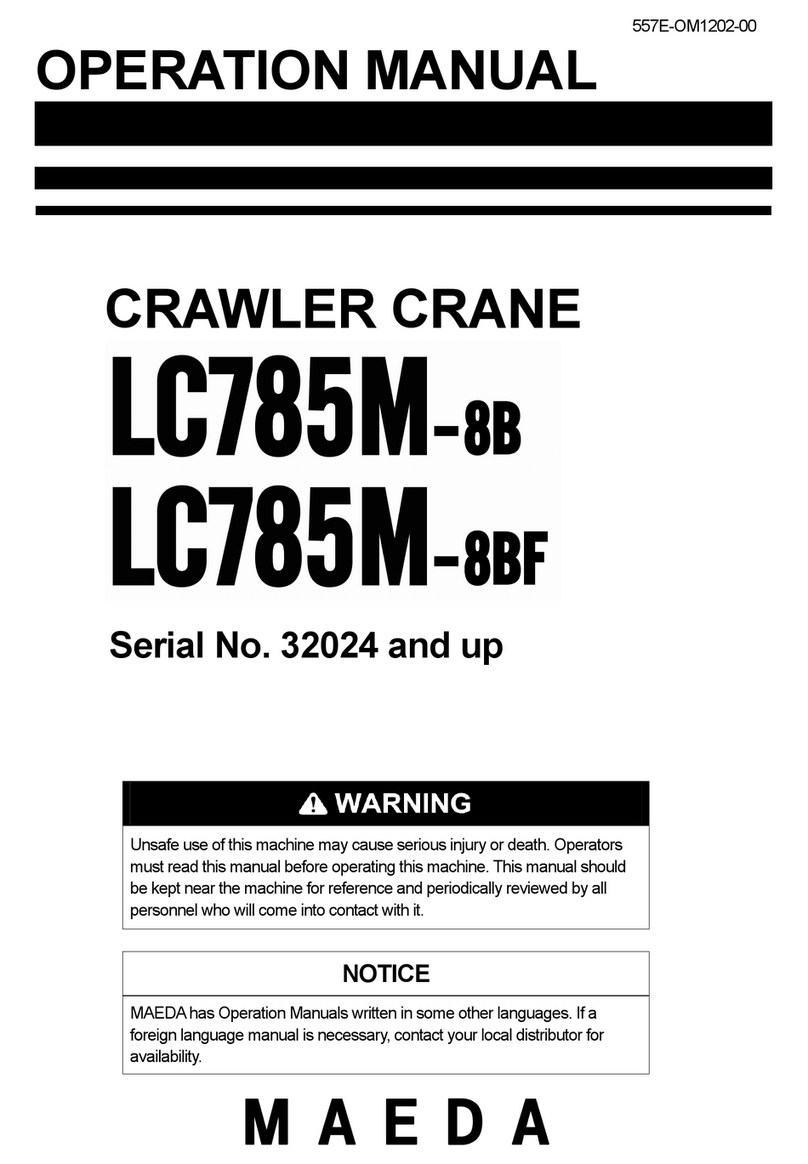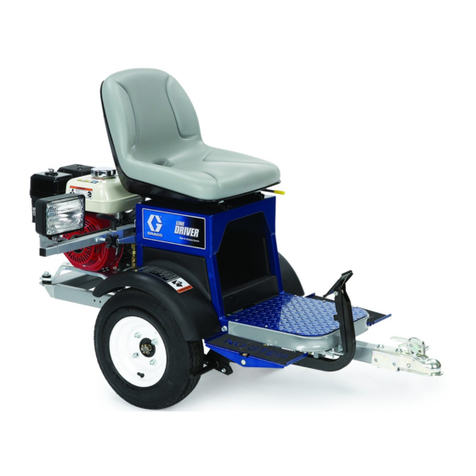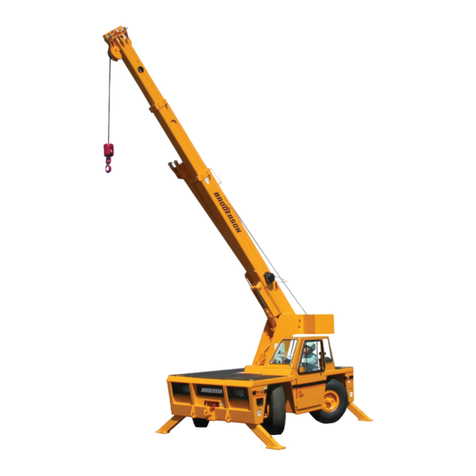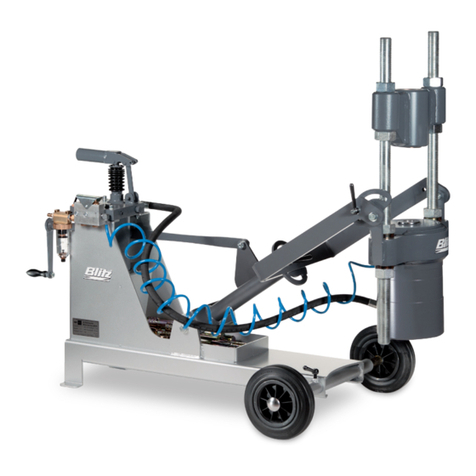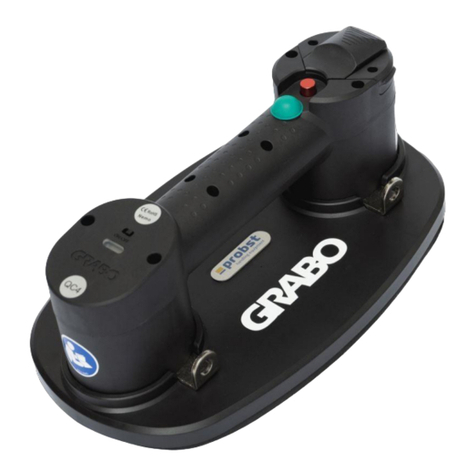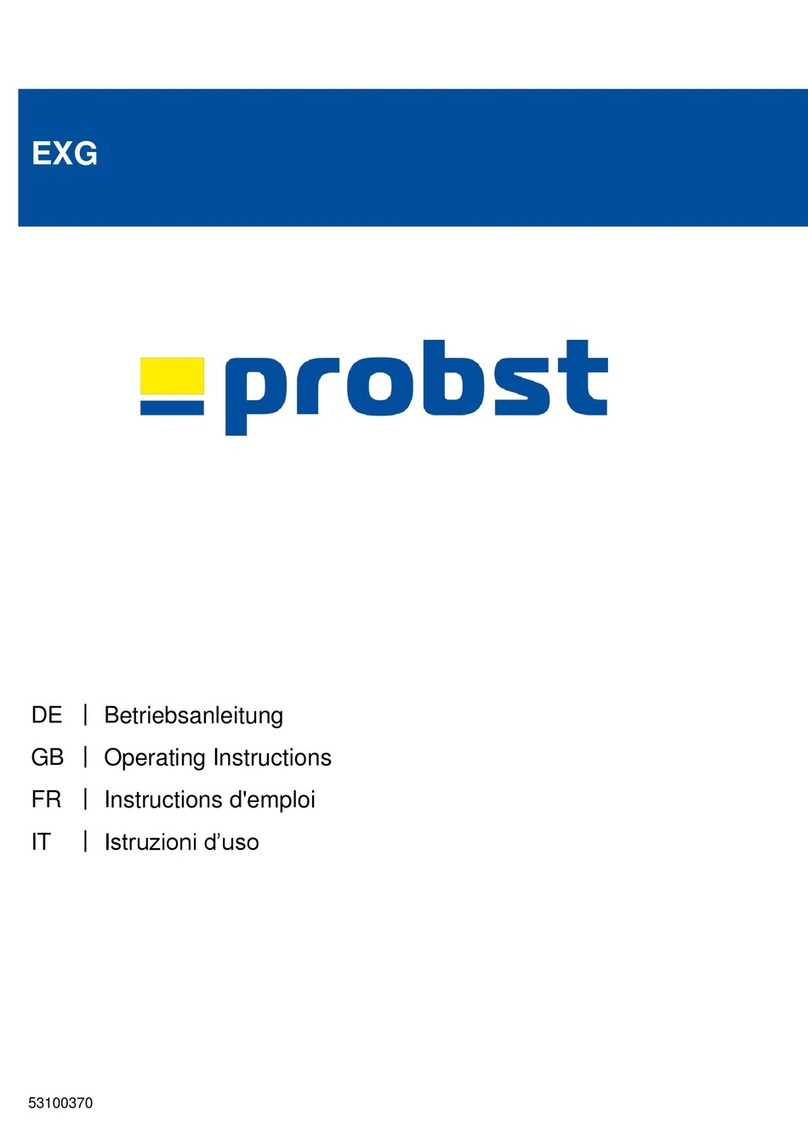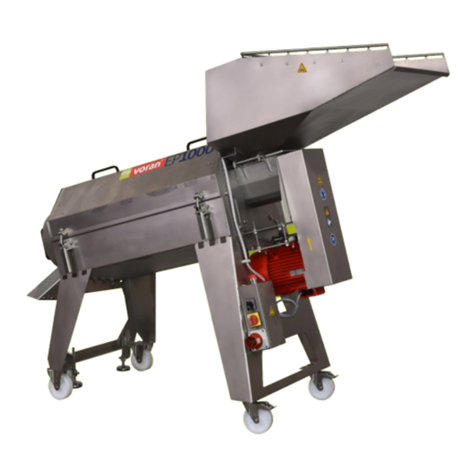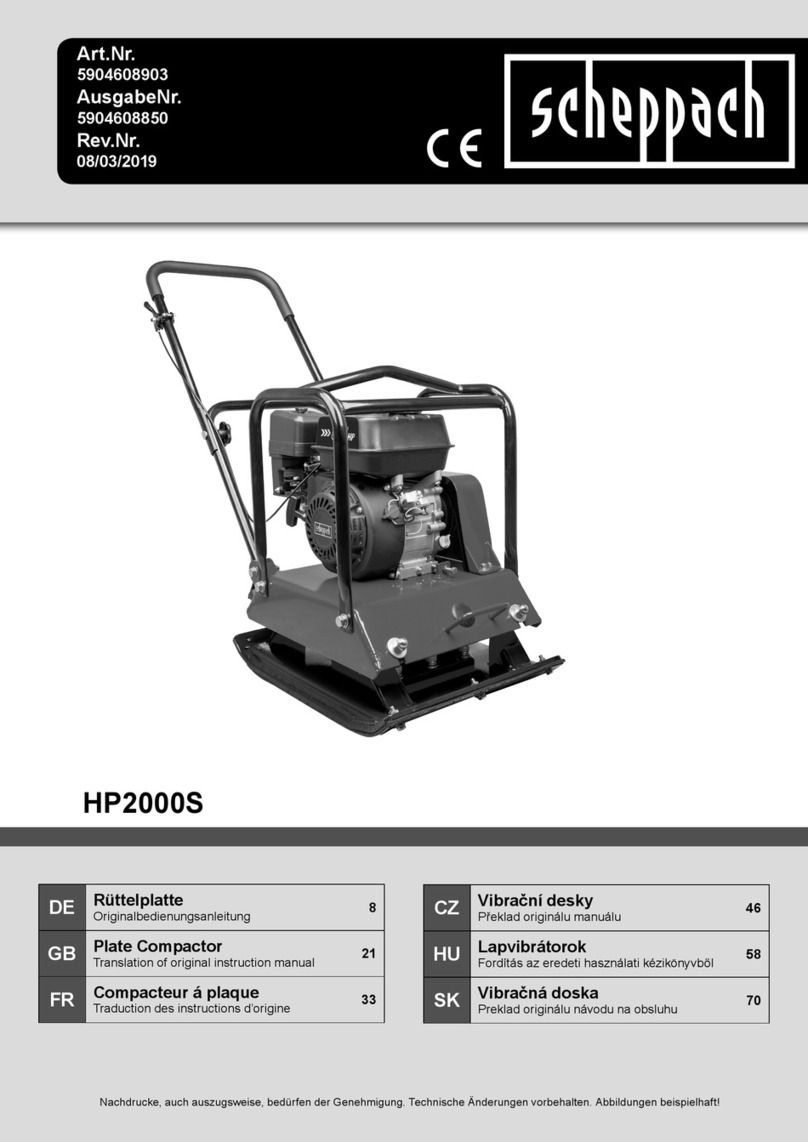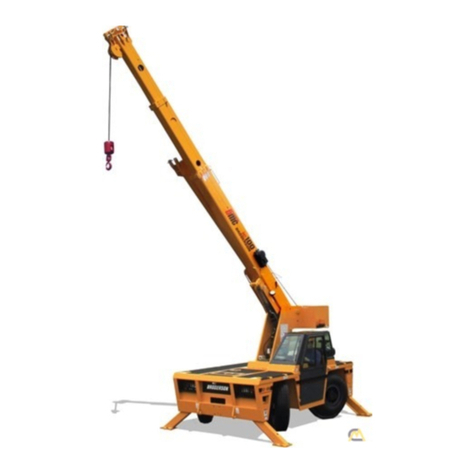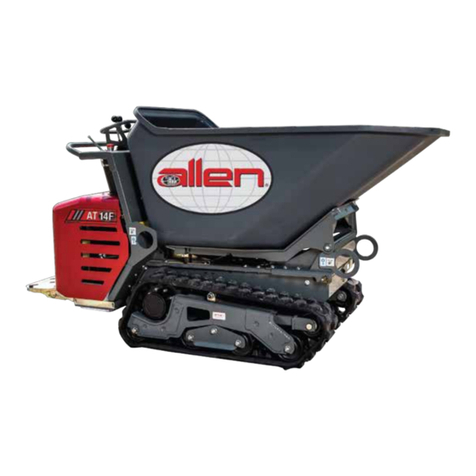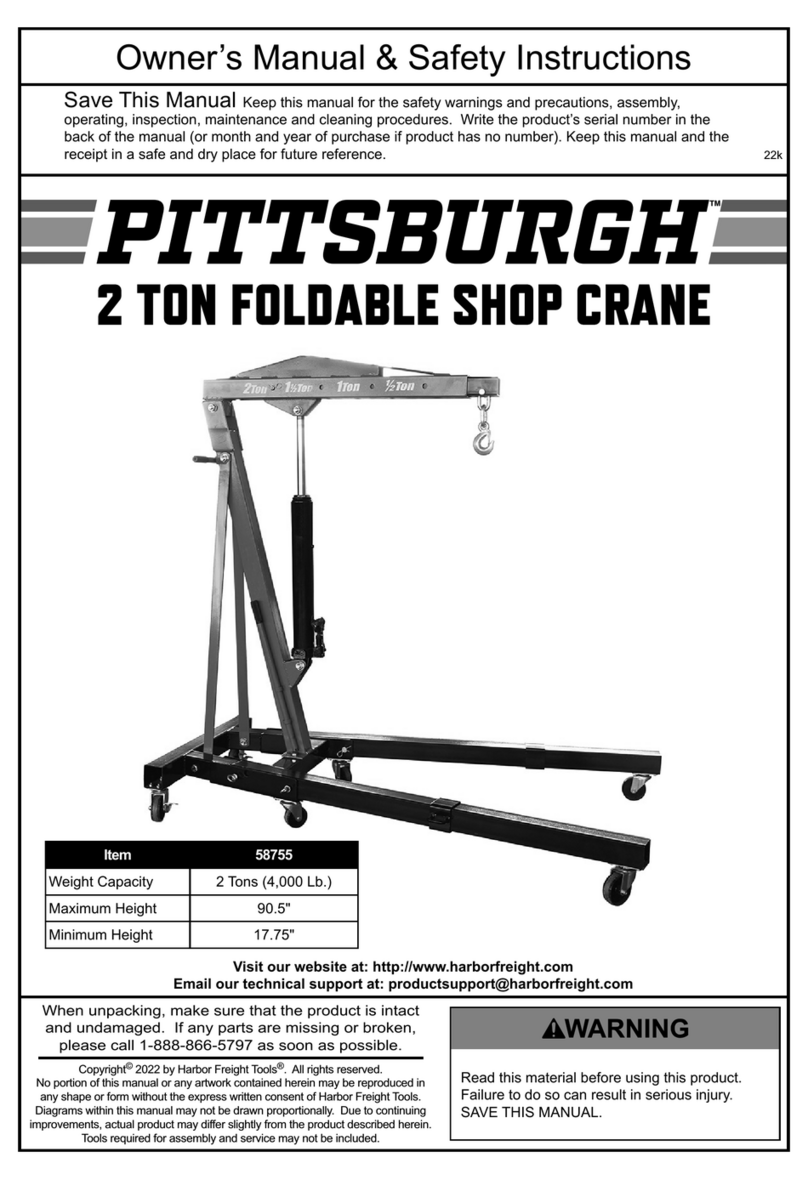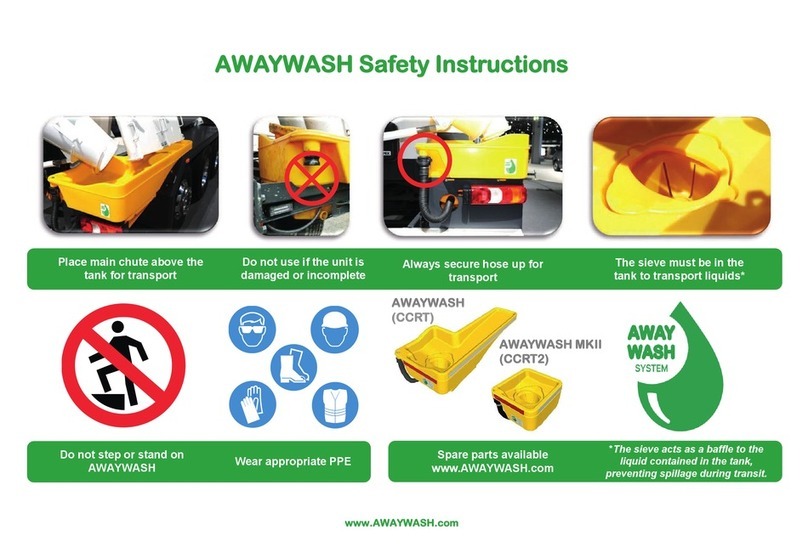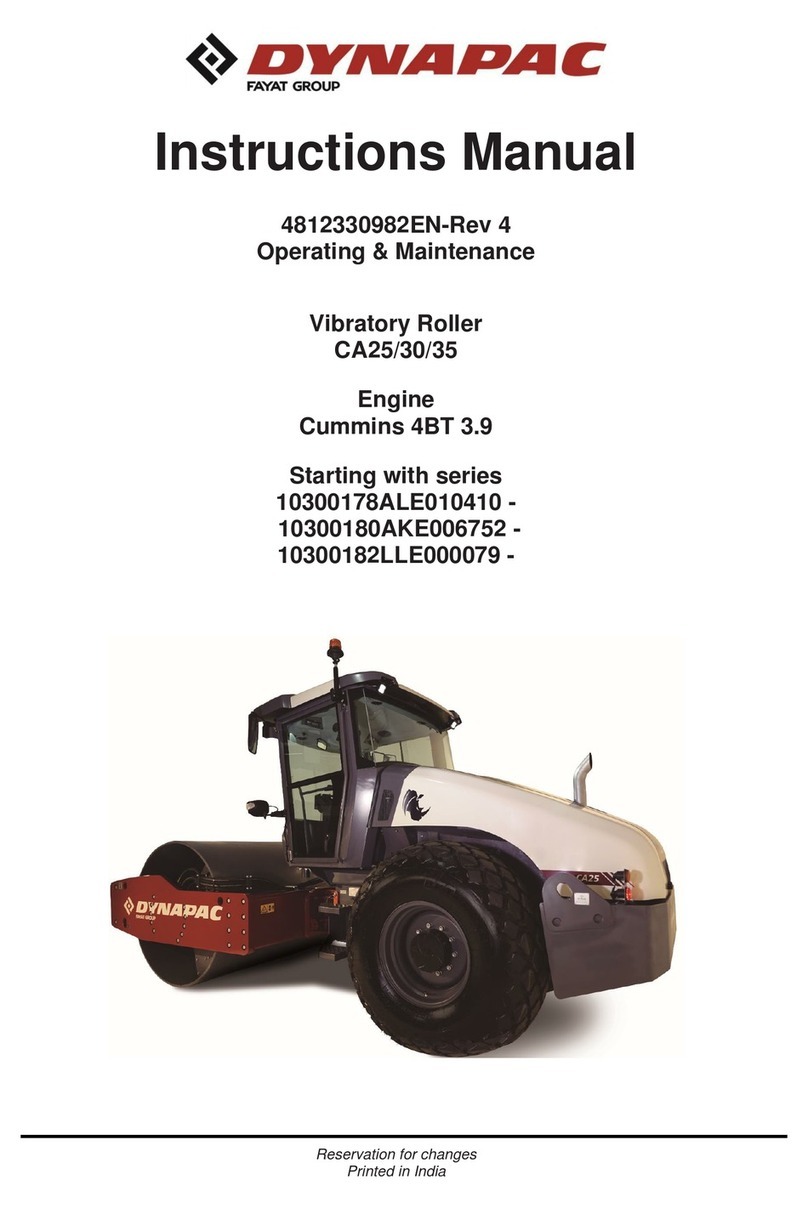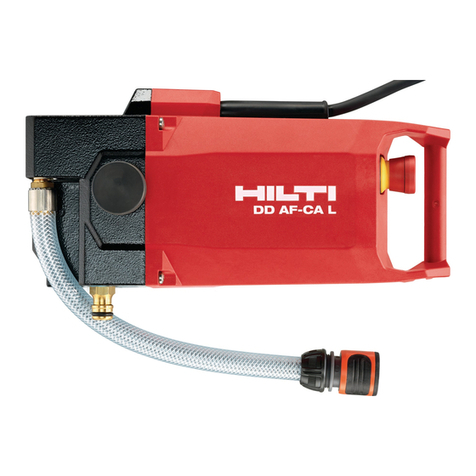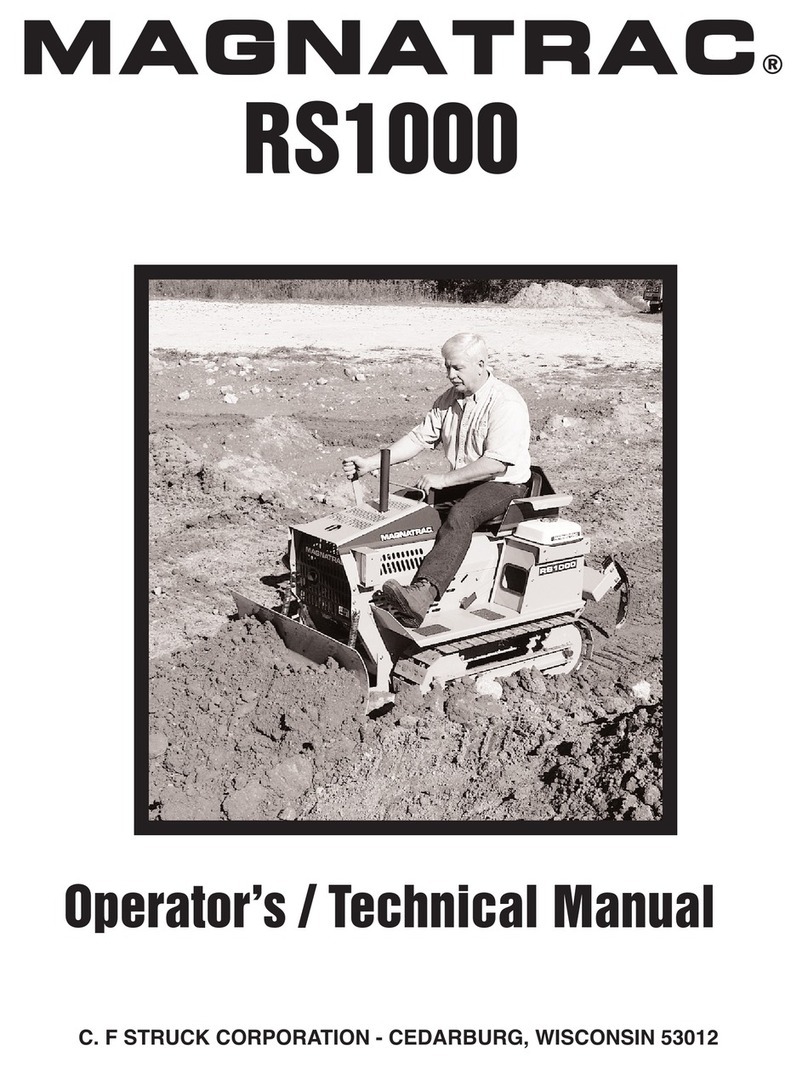Maeda MC285CB-3 User manual

Mini-Crawler Crane
Operation Manual
102BE-OM2009-00

Improper use of this machine can lead to
serious injury.
The operators and maintenance personnel
must carefully read this manual and
sufficiently understand its contents before
operation / inspecting / maintaining the
machine.
Keep this manual at hand to read it over
anytime.

Mini-Crawler Crane M A E D A Table of Contents
9/2020 MC285CB-3 i
Table of Contents
Section 1 INTRODUCTION
INTRODUCTION ................................................................................................................. 1-2
Section 2 SAFETY
SAFETY DEFINITIONS....................................................................................................... 2-2
SAFETY PRECAUTIONS.................................................................................................... 2-2
SAFETY LABEL LOCATIONS............................................................................................. 2-9
Machine Body ............................................................................................................ 2-9
Searcher Hook (Option)........................................................................................... 2-21
Section 3 SPECIFICATIONS, TERMINOLOGY AND
CAPACITY CHARTS
MACHINE FEATURES........................................................................................................ 3-2
Main Features ............................................................................................................ 3-2
Travelling Dolly ..................................................................................................... 3-2
Crane .................................................................................................................... 3-2
Safety Devices ...................................................................................................... 3-2
CRANE TERMINOLOGY .................................................................................................... 3-3
Terms and Definitions................................................................................................ 3-3
PRINCIPLE SPECIFICATIONS LIST.................................................................................. 3-4
Machine Specifications .............................................................................................. 3-4
Radio Remote Control System Specifications........................................................... 3-6
Searcher Hook Specifications ................................................................................... 3-7
DIMENSIONAL DRAWINGS ............................................................................................... 3-8
Machine Dimensional Drawing .................................................................................. 3-8
Searcher Hook Dimensional Drawing........................................................................ 3-8
Outrigger Width Dimensional Drawing ...................................................................... 3-9
RATED TOTAL LOAD CHARTS ....................................................................................... 3-10
Programmable Moment Limiter ............................................................................... 3-10
Reading the Angle Indicator ............................................................................... 3-10
Boom Length............................................................................................................ 3-11
Rated Total Load Chart for Standard Specification................................................. 3-13
Rated Total Load Chart–4 Falls............................................................................... 3-13
Rated Total Load Chart–2 Falls............................................................................... 3-14
Rated Total Load Chart–Single Fall ........................................................................ 3-14
Rated Total Load Chart for Searcher Hook............................................................. 3-15
Rated Total Load Chart for Searcher Hook-SH1..................................................... 3-16

Table of Contents Mini-Crawler Crane M A E D A
ii 9/2020 MC285CB-3
Rated Total Load Chart for Searcher Hook-SH2..................................................... 3-17
Rated Total Load Chart for Searcher Hook-SH3..................................................... 3-18
WORKING RADIUS/LIFTING HEIGHT............................................................................. 3-19
Standard................................................................................................................... 3-19
Working Radius/Lifting Height for Searcher Hook................................................... 3-21
Section 4 OPERATION
MACHINE COMPONENTS ................................................................................................. 4-2
BATTERY COMPONENTS ................................................................................................. 4-4
TRAVEL CONTROLS.......................................................................................................... 4-6
Control Location......................................................................................................... 4-6
Switches..................................................................................................................... 4-7
Motor Speed Adjuster Dial.................................................................................... 4-7
L. H. Travel Lever/Locking lever........................................................................... 4-7
R. H. Travel Lever/Locking lever .......................................................................... 4-7
Starter Switch........................................................................................................ 4-7
Emergency Stop Switch (EMO)............................................................................ 4-8
Horn Switch........................................................................................................... 4-8
13BWorking Light Switch ............................................................................................ 4-8
CRANE AND BOOM CONTROLS ...................................................................................... 4-9
Control Location......................................................................................................... 4-9
Controls.................................................................................................................... 4-10
Slewing Lever ..................................................................................................... 4-10
Boom Telescoping Lever .................................................................................... 4-10
Winch Lever ........................................................................................................ 4-10
Boom Lift Lever................................................................................................... 4-10
Emergency Stop Switch (EMO).......................................................................... 4-10
Horn Switch......................................................................................................... 4-10
MONITOR .......................................................................................................................... 4-11
16BStarting Screen ........................................................................................................ 4-11
17BHome Screen ........................................................................................................... 4-12
31B41BUser Mode ............................................................................................................... 4-17
56BWarning Display....................................................................................................... 4-22
COLD WEATHER OPERATION ....................................................................................... 4-25
STARTING......................................................................................................................... 4-26
Starting the Machine................................................................................................ 4-26
WARM-UP ......................................................................................................................... 4-27
STOPPING ........................................................................................................................ 4-28
Normal Stopping ...................................................................................................... 4-28
Emergency Stopping ............................................................................................... 4-28
TRAVELLING POSITION .................................................................................................. 4-29
TRAVELLING CONTROLS AND OPERATION ................................................................ 4-29
Directional Controls ................................................................................................. 4-31

Mini-Crawler Crane M A E D A Table of Contents
9/2020 MC285CB-3 iii
PARKING........................................................................................................................... 4-33
OUTRIGGER SAFETY DEVICES..................................................................................... 4-35
Safety Device Activation Warnings.......................................................................... 4-35
OUTRIGGER COMPONENTS .......................................................................................... 4-37
OUTRIGGER INDICATORS.............................................................................................. 4-38
Outrigger Mode........................................................................................................ 4-41
OUTRIGGER SETTING .................................................................................................... 4-43
Support Plates ......................................................................................................... 4-43
Setting Outriggers (Normal Outrigger State)........................................................... 4-44
Setting Outriggers (Multi Outrigger State) ............................................................... 4-47
OUTRIGGER SETTING MODES ...................................................................................... 4-48
"MAX" Outrigger Position......................................................................................... 4-48
"Other than MAX" Outrigger Position ...................................................................... 4-49
Crane Operation Prohibited Zones Due to Outrigger Rotary Angle........................ 4-50
Working Areas Based On Outrigger Posture .......................................................... 4-51
OUTRIGGER STOWING................................................................................................... 4-53
Procedures after Starting the Machine.................................................................... 4-53
Procedures When Stopping the Machine................................................................ 4-54
Operation in Emergencies ....................................................................................... 4-55
CRANE SAFETY DEVICES .............................................................................................. 4-56
Interlock Characteristics .......................................................................................... 4-57
Crane Operations..................................................................................................... 4-58
Crane Stowing Operations....................................................................................... 4-58
CRANE OPERATION ........................................................................................................ 4-59
Before Crane Operation........................................................................................... 4-61
Crane Operation Position ........................................................................................ 4-62
Motor Speed Operation ........................................................................................... 4-62
Travelling operation unit (only when travelling) .................................................. 4-62
Monitor (Only During Crane/Outrigger Operation) ............................................. 4-63
Radio Remote Control (Only When Operating under Radio Remote Control) .. 4-63
Hook Raising / Lowering Operation......................................................................... 4-63
Hook Raising / Lowering Procedure................................................................... 4-64
Boom Lifting Operation ............................................................................................ 4-65
Safety Precautions.............................................................................................. 4-65
Boom Lifting / Lowering Procedure .................................................................... 4-65
Boom Telescoping Operation .................................................................................. 4-65
Safety Precautions.............................................................................................. 4-65
Boom Telescoping Procedure ............................................................................ 4-66
Slewing Operation.................................................................................................... 4-66
Safety Precautions.............................................................................................. 4-66
Slewing Procedure.............................................................................................. 4-67
Crane Stowing Operation ........................................................................................ 4-67
Safety Precautions.............................................................................................. 4-67
Stowing Procedure.............................................................................................. 4-68

Table of Contents Mini-Crawler Crane M A E D A
iv 9/2020 MC285CB-3
MOMENT LIMITER (OVERLOAD DETECTOR)............................................................... 4-69
Moment Limiter Features......................................................................................... 4-69
Programmable Moment Limiter ............................................................................... 4-70
Moment Limiter Operation ....................................................................................... 4-71
Prohibited Actions after Auto-Stop .......................................................................... 4-74
Recovery Operation after Auto-Stop ....................................................................... 4-74
Moment Limiter Display ........................................................................................... 4-76
Over Winding Detector ............................................................................................ 4-80
Moment Limiter Working Envelope Setting ............................................................. 4-81
Setting or Cancelling the Upper Limit Value of Lifting Height ............................ 4-81
Setting or Cancelling the Boom Angle Upper Limit Value/Lower Limit Value.... 4-82
Setting or Cancelling the Upper Limit Value of the Working Radius.................. 4-82
Setting/Resetting Slewing Angle Limits .............................................................. 4-83
Moment Limiter Override Switch ............................................................................. 4-83
BATTERY HANDLING....................................................................................................... 4-84
Action When the Battery Is Drained ........................................................................ 4-86
Battery Charging...................................................................................................... 4-87
Monitor Display When Charging......................................................................... 4-87
User Mode Switch............................................................................................... 4-87
Rotary Lamp ON/OFF Selection......................................................................... 4-87
Charging Method ................................................................................................ 4-88
RADIO REMOTE CONTROL SYSTEM INTRODUCTION ............................................... 4-89
General .................................................................................................................... 4-89
Operation Precautions ............................................................................................. 4-92
RADIO REMOTE CONTROL SYSTEM FEATURES........................................................ 4-94
Transmitter............................................................................................................... 4-94
Receiver................................................................................................................... 4-94
Transmitter Accessories .......................................................................................... 4-94
Functions of Radio Remote Control System ........................................................... 4-94
RADIO REMOTE CONTROL SYSTEM COMPONENTS ................................................. 4-95
Transmitter Components ......................................................................................... 4-95
Transmitter Display Components ............................................................................ 4-98
Status Indications of Display.................................................................................. 4-101
Receiver Components ........................................................................................... 4-102
RADIO REMOTE CONTROL SYSTEM VERIFICATIONS ............................................. 4-104
Before Turning On Transmitter.............................................................................. 4-104
After Turning On Transmitter................................................................................. 4-104
After Starting Machine ........................................................................................... 4-104
RADIO REMOTE CONTROL SYSTEM OPERATION.................................................... 4-107
Powering ON.......................................................................................................... 4-108
Starting/Stopping the Machine .............................................................................. 4-108
Starting the Machine......................................................................................... 4-108
Stopping the Machine ....................................................................................... 4-108
Operation after Machine Is Started........................................................................ 4-108
Operation before Work...................................................................................... 4-108
Switching Operation Mode................................................................................ 4-108

Mini-Crawler Crane M A E D A Table of Contents
9/2020 MC285CB-3 v
Outrigger Operation ............................................................................................... 4-109
Outrigger Setting............................................................................................... 4-110
Outrigger Stowage............................................................................................ 4-111
Crane Operation .................................................................................................... 4-112
Hook Raising/Lowering Operation.................................................................... 4-112
Boom Lifting/Lowering Operation ..................................................................... 4-113
Boom Telescoping Operation ........................................................................... 4-113
Slewing Operation............................................................................................. 4-114
Micro Speed Mode Switch Operation............................................................... 4-114
Emergency Stop Switch (EMO) Operation....................................................... 4-114
Horn Switch Operation........................................................................................... 4-115
Boom Lift Bypass Switch Operations .................................................................... 4-115
LED Light Operations ............................................................................................ 4-116
AFTER CRANE OPERATION......................................................................................... 4-116
Crane Stowing Operation ...................................................................................... 4-116
Stopping Operation by Radio Remote Control System......................................... 4-116
Inspection after Ending Remote Control System Operation ................................. 4-117
HANDLING TRANSMITTER BATTERY.......................................................................... 4-117
Replacement Timing of Battery ............................................................................. 4-117
Replacement Method of Battery ............................................................................ 4-117
Charging Method of Battery................................................................................... 4-118
SEARCHER HOOK SAFETY PRECAUTIONS............................................................... 4-120
Moment Limiter Settings ........................................................................................ 4-120
Searcher hook position settings........................................................................ 4-120
SEARCHER HOOK COMPONENTS (OPTION)............................................................. 4-121
SEARCHER HOOK MONITOR....................................................................................... 4-122
Home Screen ......................................................................................................... 4-122
User Mode ............................................................................................................. 4-123
SEARCHER HOOK OPERATION................................................................................... 4-124
TRAILERING ................................................................................................................... 4-127
Ramp Planks.......................................................................................................... 4-128
Loading / Unloading Procedure ............................................................................. 4-128
HOISTING........................................................................................................................ 4-129
Recommended Hoisting Attachments ................................................................... 4-129
Hoisting Procedure ................................................................................................ 4-129
Section 5 MAINTENANCE AND INSPECTION
GENERAL MAINTENANCE INFORMATION AND PRECAUTIONS.................................. 5-2
MACHINE BREAK-IN .......................................................................................................... 5-5
LEGAL INSPECTION .......................................................................................................... 5-6
CONSUMABLES ................................................................................................................. 5-6
LUBRICATING OIL.............................................................................................................. 5-7

Table of Contents Mini-Crawler Crane M A E D A
vi 9/2020 MC285CB-3
SPECIAL TOOLS AND STANDARD TIGHTENING TORQUE........................................... 5-8
Accessory Tools......................................................................................................... 5-8
Standard Tightening Torque List ............................................................................... 5-8
Bolt and Nut Tightening Torque............................................................................ 5-8
Hose Connector Tightening Torque ................................................................... 5-10
MACHINERY COVER ....................................................................................................... 5-11
Removing Machinery Cover ............................................................................... 5-11
Installing Machinery Cover ................................................................................. 5-11
FUSES ............................................................................................................................... 5-12
INSPECTION ..................................................................................................................... 5-13
Pre-Start and Post-Start Inspection Items............................................................... 5-13
Pre-Start Visible Checks.......................................................................................... 5-14
Pre-Start Inspection ................................................................................................. 5-16
Post-Start Inspection ............................................................................................... 5-18
PERIODIC MAINTENANCE.............................................................................................. 5-24
Periodic Maintenance Schedule .............................................................................. 5-24
Periodic Maintenance Procedures........................................................................... 5-25
GENERAL MACHINE MAINTENANCE ............................................................................ 5-35
Rubber Tracks ......................................................................................................... 5-35
Wire Rope ................................................................................................................ 5-41
Wire Rope - Boom Telescope Extension ................................................................ 5-46
Air Breather Inspection ............................................................................................ 5-49
Drain Water and Sediment Inside Hydraulic Oil Tank............................................. 5-51
STORAGE ......................................................................................................................... 5-52
Temporary Storage.................................................................................................. 5-52
Long-Term Storage.................................................................................................. 5-52
Before Storage.................................................................................................... 5-52
During Storage.................................................................................................... 5-52
After Storage....................................................................................................... 5-52
COLD TEMPERATURE PREPARATION ......................................................................... 5-53
Oil............................................................................................................................. 5-53
Battery...................................................................................................................... 5-53
After Daily Operation ............................................................................................... 5-53
SEARCHER HOOK INSPECTION AND MAINTENANCE................................................ 5-54
Legal Inspection....................................................................................................... 5-54
Consumables ........................................................................................................... 5-54
Inspection and Maintenance List............................................................................. 5-55
Pre-Start and Post-Start Inspection Items.......................................................... 5-55
Pre-Start – Before Starting Machine........................................................................ 5-56
E-Boom, Frame and Hook .................................................................................. 5-56
Greasing.............................................................................................................. 5-56
Searcher Hook Fix Bolts ..................................................................................... 5-56
Position Pin and Lynch Pin ................................................................................. 5-56
Pre-Start – After Starting Machine........................................................................... 5-57
Moment Limiter for Operation (Searcher Hook Mode) ....................................... 5-57

Mini-Crawler Crane M A E D A Table of Contents
9/2020 MC285CB-3 vii
TROUBLESHOOTING....................................................................................................... 5-58
Machine Body .......................................................................................................... 5-58
Electrical Components............................................................................................. 5-59
Battery...................................................................................................................... 5-59
Electric Motor ........................................................................................................... 5-60
Radio Remote Control System ................................................................................ 5-61
Error Codes.............................................................................................................. 5-62
Slewing Position Calibration .................................................................................... 5-63

Table of Contents Mini-Crawler Crane M A E D A
viii 9/2020 MC285CB-3
This Page Intentionally Left Blank

9/2020 MC285CB-3 1-1
Section 1
INTRODUCTION

Section 1 – INTRODUCTION Mini-Crawler Crane M A E D A
1-2 9/2020 MC285CB-3
INTRODUCTION
Thank you for purchasing the Maeda Mini Crawler
Crane model MC285CB-3.
This manual is intended as a guide for the safe
and effective use of this machine. This manual
describes the procedures for proper operation and
maintenance of the machine.
This manual is available in other languages. If a
different language manual is necessary, contact
your local Maeda distributor for availability.
Save this manual in a designated safe place for
future reference. Should this manual be lost or
damaged, contact Maeda or a Maeda sales
service agency immediately to order a new
manual. This manual should remain with this
machine upon transfer of the machine to a new
owner.
This manual contains information that was
available at the time of print.
The contents of this manual, including
maintenance specifications, tightening torques,
pressure, measuring methods, adjustment values
and illustrations, are subject to change upon
refinement of the machine, without notice.
Machine maintenance procedures may be
updated by Maeda at any time. Always obtain the
latest information from Maeda or a Maeda sales
service agency before performing maintenance
on this machine.
Installation and operation of this machine must
comply with all laws and regulations where
operated.
Only personnel who have obtained a licence
stipulated by the laws and regulations from the
place of use are qualified to operate this machine,
establish the power connection of the power
supply equipment, and inspect and repair the
electric system.
Disclaimers:
All information, illustrations and specifications in
this manual are based on the latest information
available at the time of publishing. The
illustrations used in this manual are intended as
representative reference views only. Moreover,
because of our continuous product improvement
policy, we may modify information, illustrations
and/or specifications to explain and/or exemplify a
product, service or maintenance improvement.
We reserve the right to make any change at any
time without notice.
Maeda is a registered trademark of Maeda
Seisakusho Co., Ltd. in Japan, the United States
and/or other countries.
All Rights Reserved:
No part of this publication may be reproduced or
used in any form by any means - graphic,
electronic or mechanical, including photocopying,
recording, taping, or information storage and
retrieval systems - without the written permission
of Maeda Seisakusho Co., Ltd.
© 2020 Maeda Seisakusho Co., Ltd.
9/2020

9/2020 MC285CB-3 2-1
Section 2
SAFETY

Section 2 – SAFETY DEFINITIONS Mini-Crawler Crane M A E D A
2-2 9/2020 MC285CB-3
SAFETY DEFINITIONS
Maeda is concerned for your safety and the
condition of your mini-crawler crane. Safety
statements are one of the primary ways to call
your attention to the potential hazards associated
with Maeda mini-crawler cranes. Follow the
precautions listed throughout the manual before
operation, during operation and during periodic
maintenance procedures for your safety, the
safety of others and to protect the performance of
your mini-crawler crane. Keep the labels from
becoming dirty or torn and replace them if they are
lost or damaged. Also, if a part needs to be
replaced that has a label attached to it, make sure
to order the new part and label at the same time.
This safety alert symbol appears with
most safety statements. It means
attention, become alert, your safety is
involved! Please read and abide by
the message that follows the safety
alert symbol.
Indicates a hazardous situation which, if not
avoided, will result in death or serious injury.
Indicates a hazardous situation which, if not
avoided, could result in death or serious injury.
Indicates a hazardous situation which, if not
avoided, could result in minor or moderate injury.
Indicates a situation which can cause damage to
the mini-crawler crane, personal property and/or
the environment, or cause the equipment to
operate improperly.
SAFETY PRECAUTIONS
There is no substitute for common sense and
careful practices. Improper practices or
carelessness can cause burns, cuts, mutilation,
asphyxiation, other bodily injury or death. This
information contains general safety precautions
and guidelines that must be followed to reduce
risk to personal safety. Special safety precautions
are listed in specific procedures. Read and
understand all of the safety precautions before
operating or performing repairs or maintenance.
This safety section cannot cover every situation
that may occur that is incidental to the use of the
machine. Use common sense if you encounter a
situation that is not covered to help avoid a
hazardous situation.
The safety messages that follow have
CAUTION level hazards.
Pre-Operation Hazard
・
Never permit anyone to install or
operate the machine without
proper training.
・Read and understand this Operation Manual
before operating or servicing the crane to
ensure that safe operating practices and
maintenance procedures are followed.
・Safety signs and labels are additional
reminders for safe operating and maintenance
techniques.
・Contact us or our sales service agency for
additional training.
・Make sure you are aware of licences, laws and
regulations that may be required or in effect
where the machine is operated.
NOTICE

M A E D A Mini-Crawler Crane Section 2 – SAFETY PRECAUTIONS
9/2020 MC285CB-3 2-3
The safety messages that follow have
DANGER level hazards.
Electrocution Hazard
Contact with, or proximity to, an electrically
charged power line will result in death or serious
injury:
・This unit will not provide protection from contact
with, or proximity to, an electrically charged
power line when the components at the boom
tip are in contact with, or in proximity to, another
power line, ground or pole.
・All metal and fiberglass components at the
boom tip may become energised.
・Operators must follow safe electrical work
practices in accordance with their employers’
work rules and applicable government
regulations including:
・Maintain minimum approach distances
from electrical power lines.
・Allow for boom, electric line and load sway.
・If any part of the unit is elevated within the
minimum approach distance of an energised
conductor, all unauthorised personnel must
KEEP CLEAR.
・There is a risk of electric shock if the battery unit
is handled incorrectly.
The safety messages that follow have
WARNING level hazards.
Tip / Boom Failure Hazard
Overloading the crane may cause it to tip over or
the boom to fail:
・Before you try to hoist a load, it is essential that
you know:
・Boom angle (use boom angle indicator)
・Working radius (use operating range chart)
・Boom length (use rated total load chart)
・Rated total load (use rated total load chart)
・Never try to hoist a load that exceeds the rated
total load. Rated total load is the mass of the
load plus weight of the winch lines and the
weight of the hook block.
・Always calculate the total load using the rated
total load chart before you attempt to hoist the
load. Never rely on the moment limiter as the
primary means to determine whether a load is
safe to lift.
・All the values provided on the rated total load
chart assume that the machine is located on a
level and firm surface. Always use outrigger
pads when you deploy the outriggers on soft or
unpaved surfaces.
・The values shown in the operating range chart
do not account for boom deflection when the
load is raised. Boom deflection will widen the
working radius. Use the next largest radius on
the operating range chart to account for this.
・Always extend outriggers before lifting load. If
the terrain is not completely level and you must
adjust the outrigger position to compensate, you
must derate the rated total load by the amount
indicated for outriggers other than maximum in
"RATED TOTAL LOAD CHARTS" on page 3-13.
All outrigger monitor lights, other than the Boom
Stowing Light, must be on.
・Always look at the level gauge when setting the
outriggers. Look at the level gauge when
making adjustments during operation. Always
keep the machine body level when operating.
・Sudden or jerky movement of the travel, crane or
outrigger controls can cause the machine to tip
over. Always operate these controls smoothly.

Section 2 – SAFETY PRECAUTIONS Mini-Crawler Crane M A E D A
2-4 9/2020 MC285CB-3
The safety messages that follow have
WARNING level hazards.
Crush Hazard
・
Keep bystanders away from
work area before and during
operation.
・Keep all body parts clear of machine
components during operation, especially
between the boom/post and the boom cylinder,
the winch drum and the winch line, the sheaves
and the winch line, and between the tracks and
the ground.
・Never commence work unless you have clear
view of the jobsite or you have a helper to guide
you.
・Always lower the load fully to the ground before
you leave the operator’s position.
Rigging Hazard
・Pay attention to the distance between the hook
block and the boom when you raise the hook
block or when you extend the boom (as the
boom extends, the hook block automatically
raises). If the hook block strikes the boom, it
could cause the load to fall.
・Never overload the winch line.
・When you are lowering the hook block, make
sure there are more than three turns of winch
line left on the winch drum when the hook block
reaches the final working height.
・Before you hoist the load, make sure the hook
block is securely attached to the winch line.
・Make sure the winch line is perpendicular to the
ground as you hoist a load to avoid tipping the
machine over.
・When you are hoisting a load off the ground, stop
hoisting the load momentarily as the load clears
the ground to make sure the load is stable.
・Never hoist more than one load at a time.
・When you hoist a long load, such as pipes,
clamp the load vertically or secure it at both
ends.
Slewing Hazard
・Never slew a load over anyone.
・Always slew the load as smoothly and slowly as
possible. Any sudden movement could cause
the load to sway and the machine to tip over.
・Keep away from other cranes working in the
area to avoid accidental contact.
・Never slew the load over the operator.
Wind Speed Hazard
・If the maximum instantaneous wind speed is 19
to 24 mph (8.5 to 10.7 m/s) or greater, abort the
job you are performing and immediately lower
the load and secure the boom. This wind speed
is called a “fresh wind” on the Beaufort Scale. At
that speed, small trees in leaf sway slightly and
wavelets form on ponds and lakes.
・Even if the maximum instantaneous wind speed
is below 19 to 24 mph (8.5 to 10.7 m/s), be
aware that loads with more mass, loads that are
hoisted high off the ground and booms that are
extended all magnify the effect of the wind on
the machine. Stay aware of changing weather
conditions.
・If a load is hoisted that has a large surface area,
such as a metal plate, the wind can cause the
load to sway and subsequently cause the
machine to tip over.
High Hydraulic Oil temperature
If the hydraulic oil temperature exceeds 90°C, the
electric motor will stop.
If hydraulic oil temperature exceeds 90°C
hydraulic hoses and seals can be damaged and
leak. The leaking hydraulic oil can cause burns.
Continuous hook raising and lowering at high
speeds and high lifting heights can cause the
hydraulic oil to heat up faster.
If hydraulic oil temperature exceeds 90°C stop
crane operation and allow the hydraulic oil to cool.

M A E D A Mini-Crawler Crane Section 2 – SAFETY PRECAUTIONS
9/2020 MC285CB-3 2-5
The safety messages that follow have
WARNING level hazards.
Communications Hazard
・Always work with a partner that is on the ground.
The partner must keep aware of any hazards in
the work area and communicate them to the
machine operator.
・Both the machine operator and the partner must
decide before work begins on the hand signals
that they will use during the job.
・If hand signals are not used, proper radio
communications must be set up and tested
before the job begins.
Fall Hazard
・Never carry riders on the machine.
・Always use the hand grabs and slip-resistant
surfaces when entering or exiting the machine.
・Always maintain three-point contact when
entering or exiting the machine.
・Never jump off the machine.
Modification Hazard
Never modify the machine without written consent
of the manufacturer. Any modification can affect
the safe operation of the machine.
Exposure Hazard
Always wear personal
protective equipment,
including appropriate
clothing, gloves, work shoes,
and eye and hearing
protection, as required by
the task at hand.
Explosion Hazard
・
While the battery is charging,
hydrogen gas is being produced
and can be easily ignited. Keep
the area around the battery
well-
ventilated and keep sparks,
open flame and any other form
of ignition out of the area.
・Always disconnect the negative (-) battery cable
before servicing the equipment.
Fire Hazard
・
Have appropriate safety equipment
available. Have all fire extinguishers
checked periodically for proper
operation and/or readiness.
・Always read and follow safety-related
precautions found on containers of hazardous
substances like parts cleaners, primers,
sealants and sealant removers.
・Undersized wiring systems can cause an
electrical fire.

Section 2 – SAFETY PRECAUTIONS Mini-Crawler Crane M A E D A
2-6 9/2020 MC285CB-3
The safety messages that follow have
WARNING level hazards.
Asbestos Dust Hazard
・
Inhalation of air containing asbestos
dust may result in lung cancer.
・Make sure you use the appropriate
personal protection equipment if you
suspect that the worksite may
contain asbestos.
・Properly prepare the worksite to prevent
asbestos dust from being released into the
surrounding environment.
Entanglement / Sever Hazard
・
Verify there are no people, obstacles
or other equipment near the machine
before starting the machine. Sound
the horn as a warning before starting
the machine.
・Always stop the machine before
beginning service.
・If the machine must be serviced while it is
operating, remove all jewelry, tie back long hair
and keep hands, other body parts and clothing
away from moving/rotating parts.
・Verify that all machine guards and covers are
attached properly to the machine before starting
the machine. Do not start the machine if any
guards or covers are not properly installed on
the machine.
・Always turn the Starter Switch to the OFF
position after operation is complete and remove
the key from the switch. Keep the key in your
possession when the machine is not operating.
・Attach a “Do Not Operate” tag near the Key
Switch while performing maintenance on the
equipment.
・Never operate the machine while wearing a
headset to listen to music or radio because it
will be difficult to hear the warning signals.
Alcohol and Drug Hazard
Never operate the machine while
under the influence of alcohol or drugs,
or when ill.
Piercing Hazard
・Avoid skin contact with high-pressure
hydraulic fluid caused by a hydraulic
leak such as a broken hydraulic hose
line. High-pressure hydraulic fluid
can penetrate your skin and result in
serious injury. If you are exposed to
high-pressure hydraulic fluid obtain
prompt medical treatment.
・Never check for a hydraulic fluid or fuel leak with
your hands. Always use a piece of wood or
cardboard. Have your authorised Maeda dealer
or distributor repair the damage.
Flying Object Hazard
Always wear eye protection when
cleaning the machine with
compressed air. Dust, flying debris,
compressed air, pressurised water or
steam may injure your eyes.

M A E D A Mini-Crawler Crane Section 2 – SAFETY PRECAUTIONS
9/2020 MC285CB-3 2-7
The safety messages that follow have
WARNING level hazards.
Burn Hazard
・
Items such as the motor, motor
controller, and oil will be hot
immediately after shutting down the
machine.
There is a risk of burn injuries if
maintenance is carried out in this
state.
・Keep hands and other body parts away.
・Handle hot components with heat-resistant
gloves.
Working Under Machine Hazard
・
Park the machine on a flat, firm and
level surface.
・Fully retract and lower the boom.
・Extend all outriggers to the
maximum position so the tracks
clear the ground.
・Place jack stands of sufficient strength in
strategic locations under the machine to help
support it during maintenance.
Working Above Machine Hazard
・
Always maintain three-point contact as
you climb on or off an elevated work
surface.
・Do not jump from the elevated work
surface.
・Do not climb on the boom, outrigger or other
machine surface.
・Where necessary, wear protective equipment
and a safety harness.
The safety messages that follow have
CAUTION level hazards.
Poor Lighting Hazard
Ensure that the work area is adequately
illuminated. Always install wire cages on portable
safety lights.
Tool Hazard
Always use tools appropriate for the task at hand
and use the correct size tool for loosening or
tightening machine parts.
Slip Hazard
・Immediately clean up any spilled liquid on the
shop floor.
・Clean up accumulated dirt and debris on the
shop floor at the end of each shift.
Communications Hazard
・Follow the policies and instructions established
by your employer and authorities having
jurisdiction. The policies have been developed
to protect you and your co-workers from
needless personal injury.
・Post signs to alert people that are not
authorised to be in the shop that they must stay
out of the work area.
・If you must run the machine during
maintenance procedures, make sure you have
a helper to keep bystanders clear of the
machine and make observations of moving
parts as requested by the operator.

Section 2 – SAFETY PRECAUTIONS Mini-Crawler Crane M A E D A
2-8 9/2020 MC285CB-3
The safety messages that follow have NOTICE
level hazards.
Any part which is found defective as a result of
inspection or any part whose measured value
does not satisfy the standard or limit must be
replaced.
Always tighten components to the specified
torque. Loose parts can cause equipment
damage or cause it to operate improperly.
Only use replacement parts specified. Other
replacement parts may affect warranty coverage.
Follow the guidelines of the
governmental agencies for the proper
disposal of hazardous materials such
as oil. Consult the local authorities or
reclamation facility.
Clean all accumulated dirt and debris away from
the body of the machine and its components
before you inspect the machine or perform
preventive maintenance procedures or repairs.
Operating a machine with accumulated dirt and
debris will cause premature wear of machine
components. Accumulated dirt and debris also
hinders effective machine inspection.
Retrieve any tools or parts that may have dropped
inside of the machine to avoid improper machine
operation.
Never dispose of hazardous materials by dumping
them into a sewer, on the ground, or into
groundwater or waterways.
If any alert indicator illuminates during machine
operation, stop the machine immediately.
Determine the cause and repair the problem
before continuing to operate the machine. Check
the following specifications and items before using
this machine:
・Maintenance inspection records for completion
of periodic inspections and service
・Crane capacity
・Crane maintenance condition
・Problems or failures unique to the crane
・Operating condition of the brakes, clutch and
other operating controls
・Condition and operation of lighting, including
rotating lights
・Condition and operation of hook, winches,
boom, outriggers and related components
NOTICE
Table of contents
Other Maeda Construction Equipment manuals
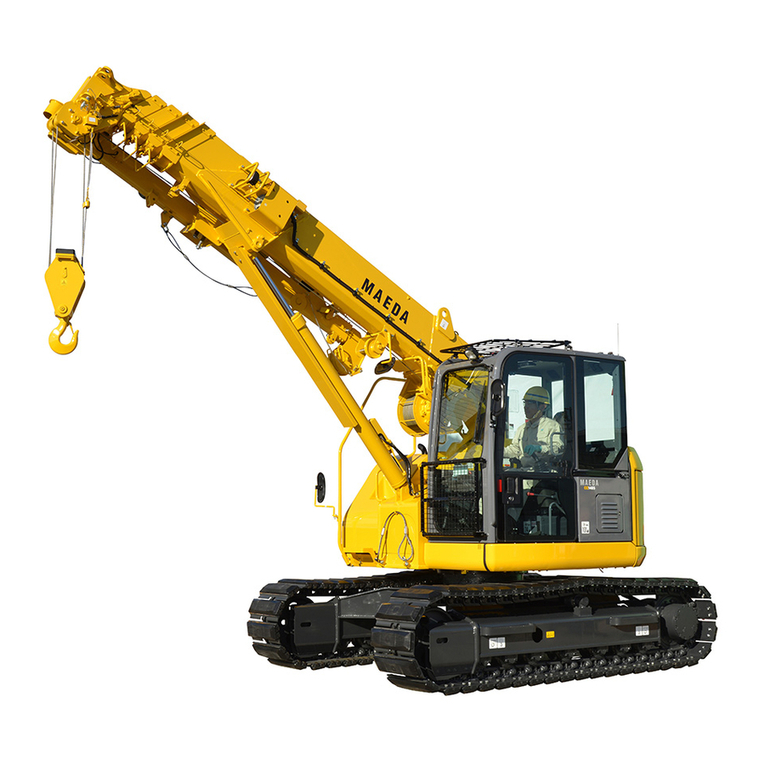
Maeda
Maeda CC1485S-1 User guide
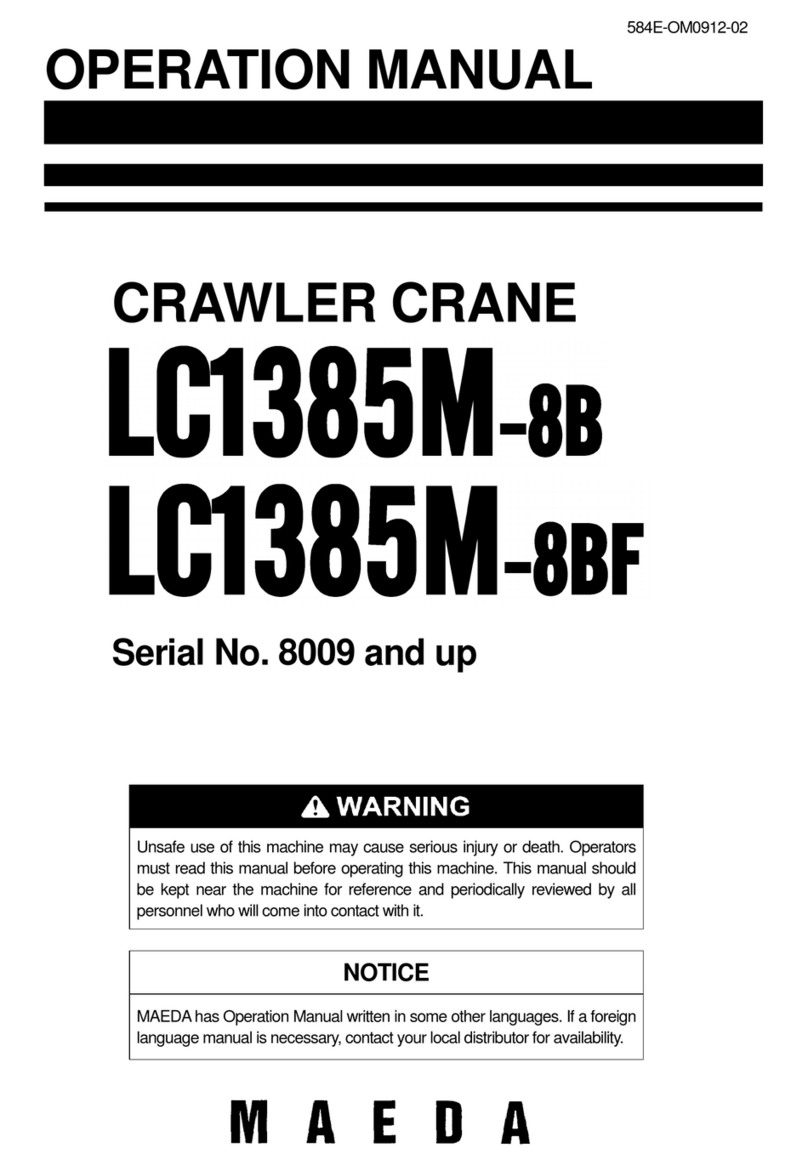
Maeda
Maeda LC1385M-8BF User manual

Maeda
Maeda MC405C-3 User manual
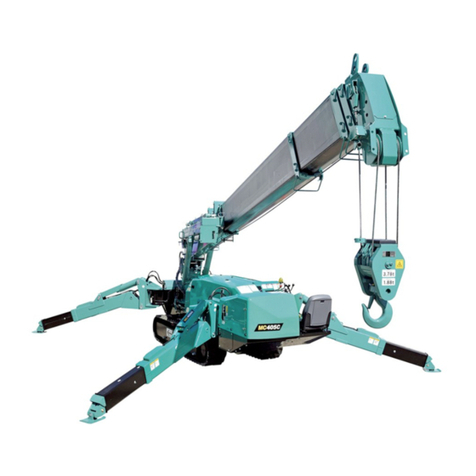
Maeda
Maeda MC-104C-2 User manual
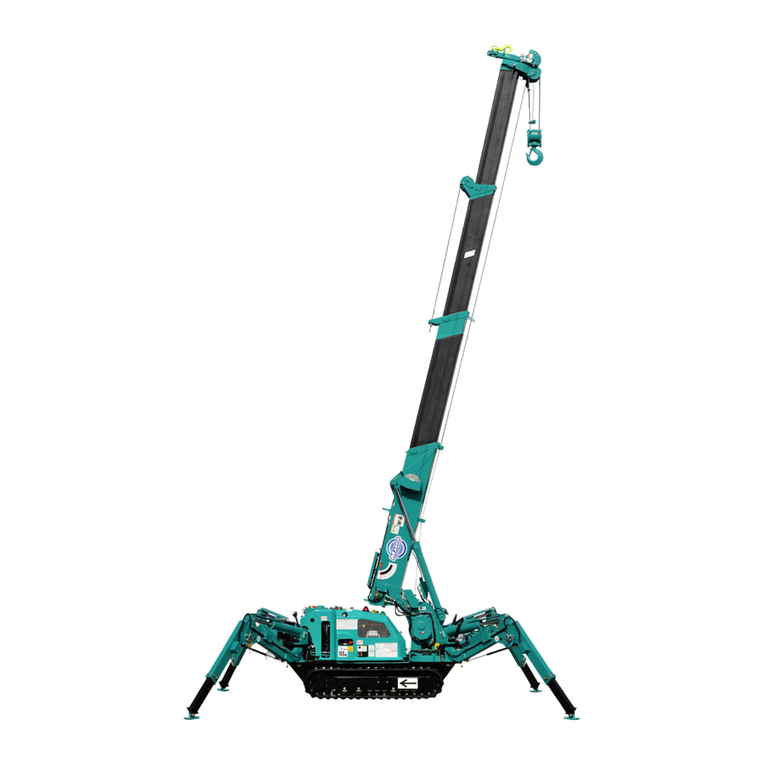
Maeda
Maeda MC-174CRM User manual
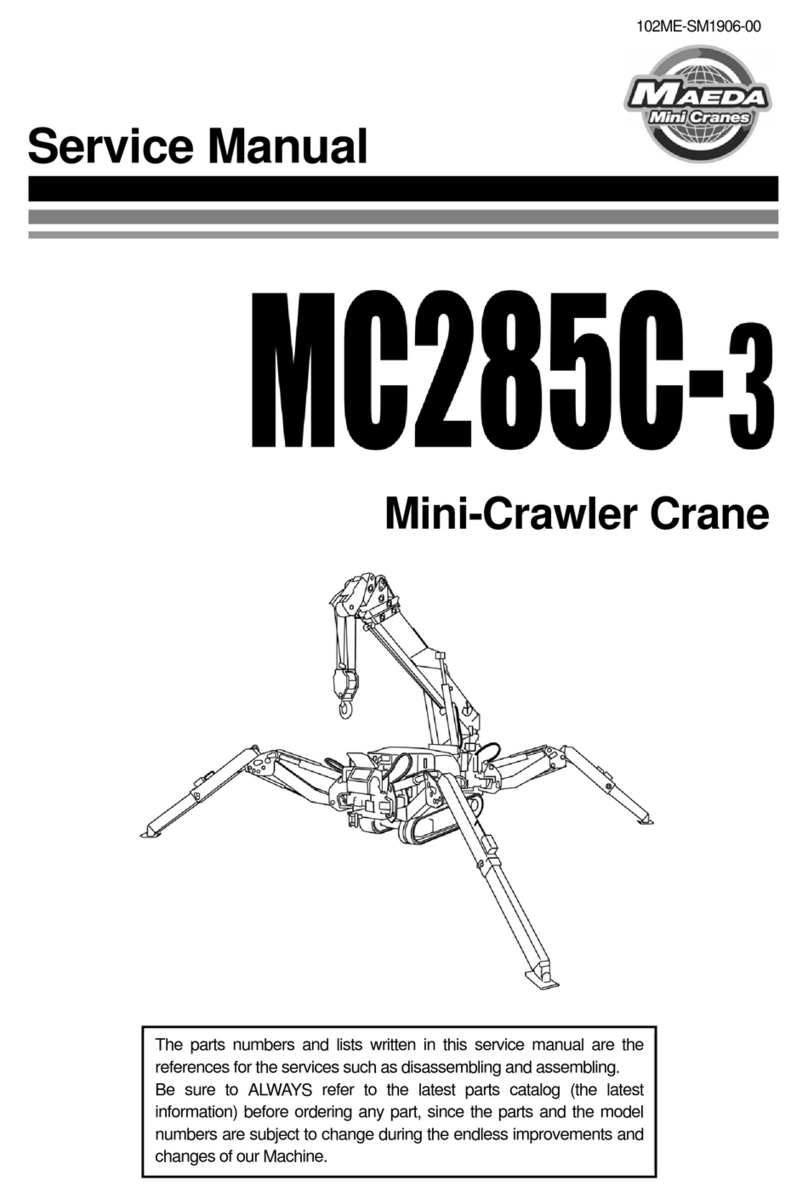
Maeda
Maeda MC285C-3 User manual
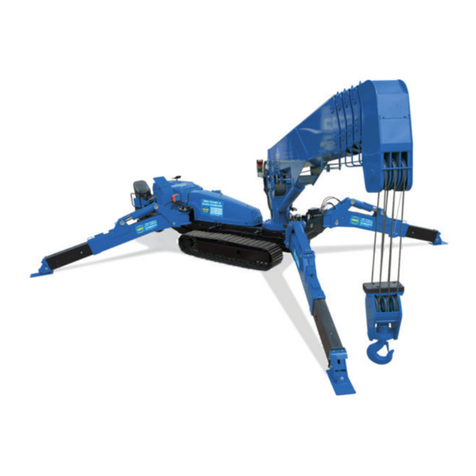
Maeda
Maeda HIRD MC815 User manual
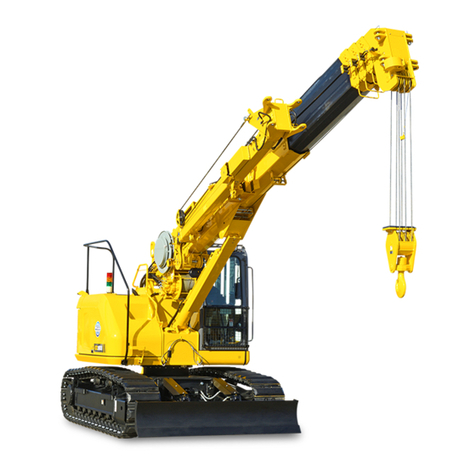
Maeda
Maeda CC1908S-1 User manual

Maeda
Maeda MC-305C-2 User guide

Maeda
Maeda CC1908S-1 User manual
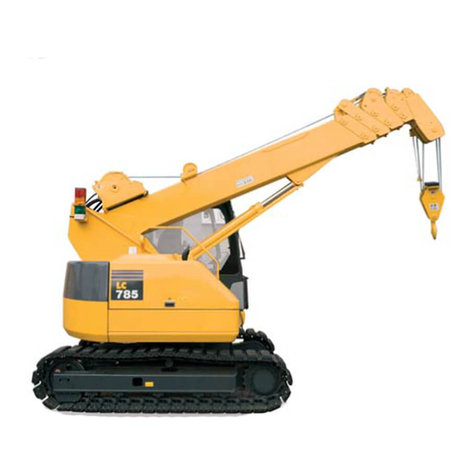
Maeda
Maeda LC785M-6B User manual
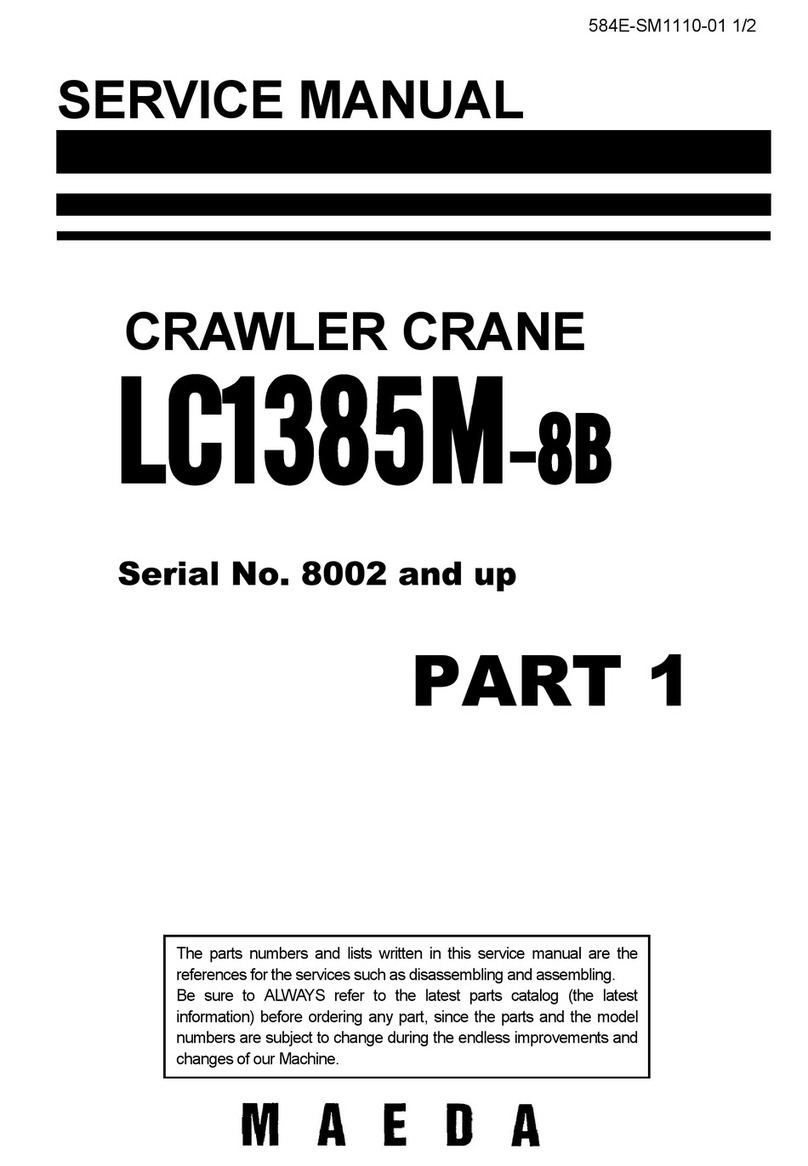
Maeda
Maeda LC1385M-8B User manual
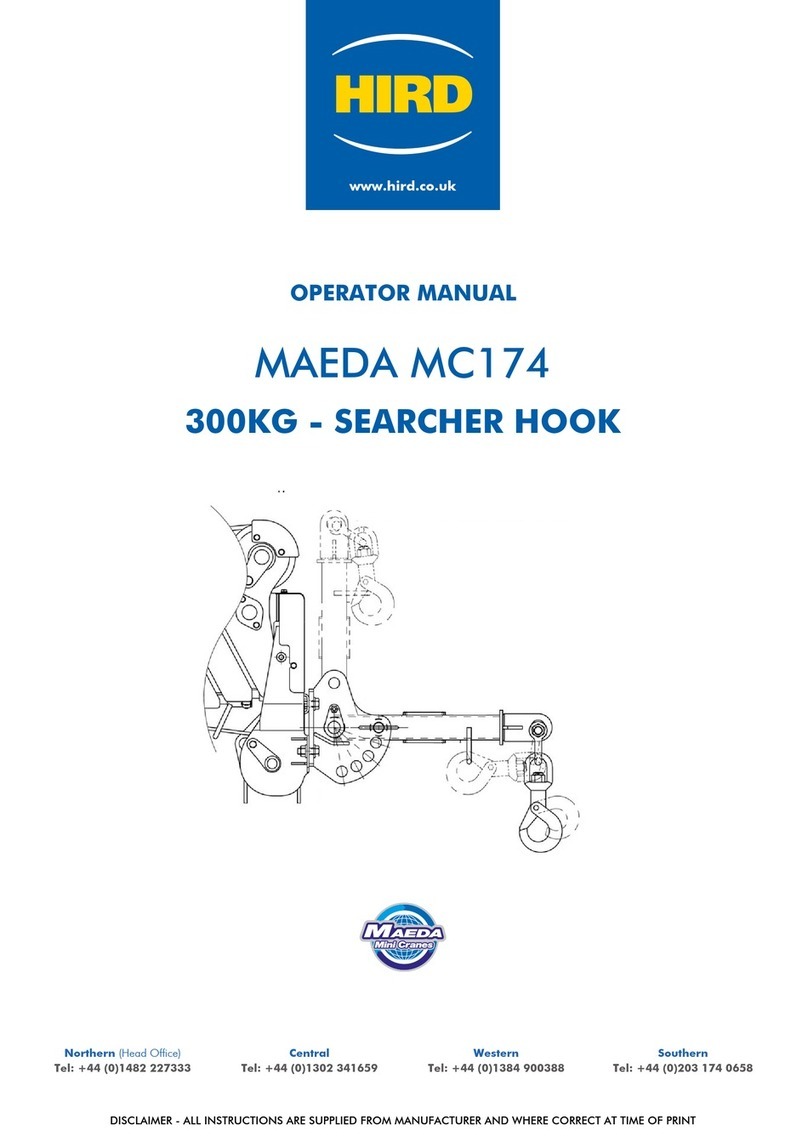
Maeda
Maeda MC174 User manual
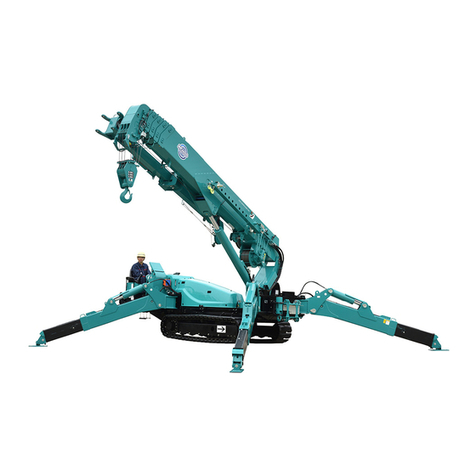
Maeda
Maeda MC815C User guide

Maeda
Maeda MC285C-2 User manual
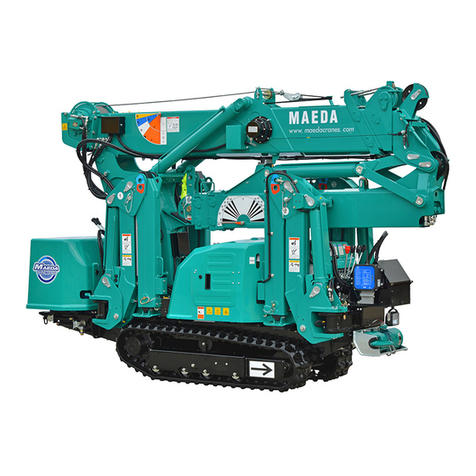
Maeda
Maeda MK1033C-1 User manual
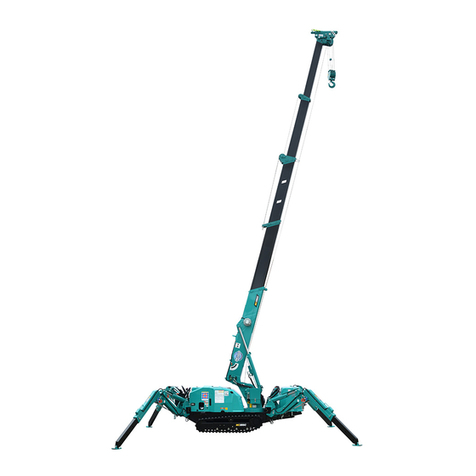
Maeda
Maeda MC285C-3 User manual
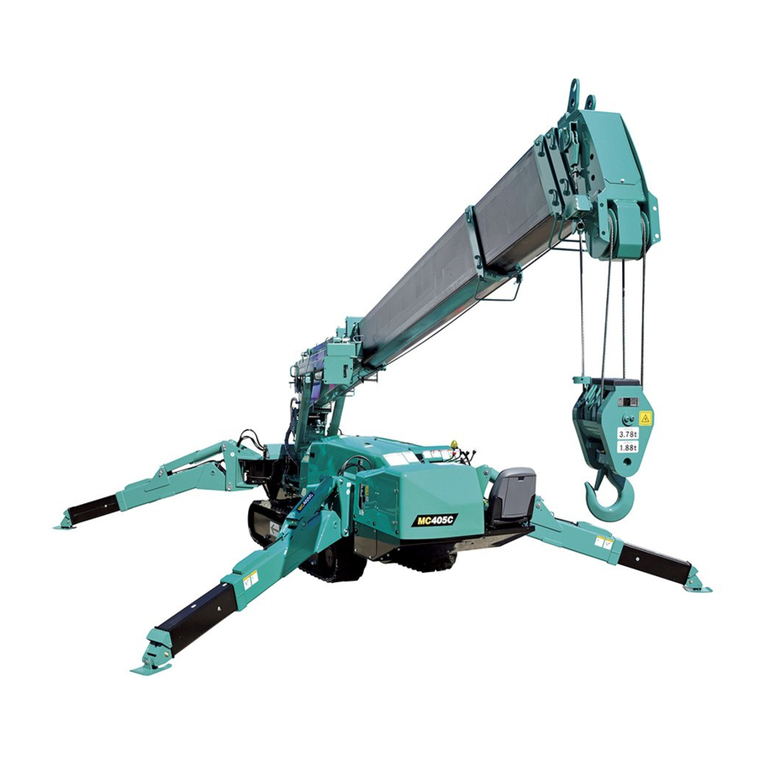
Maeda
Maeda MC405C-3 User manual
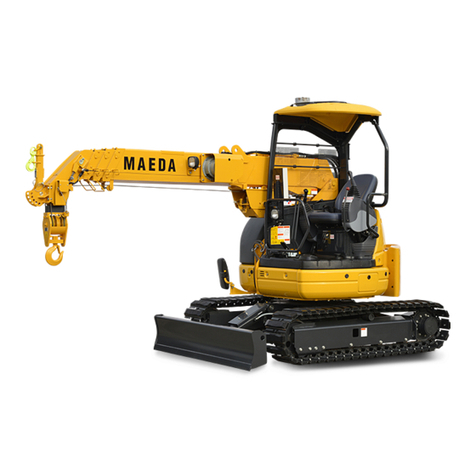
Maeda
Maeda LC383M-5 User manual
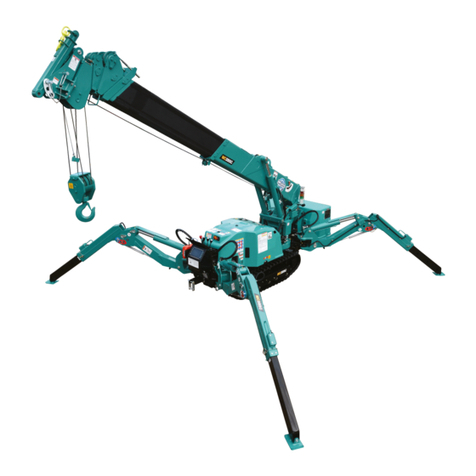
Maeda
Maeda MC-285C User guide
